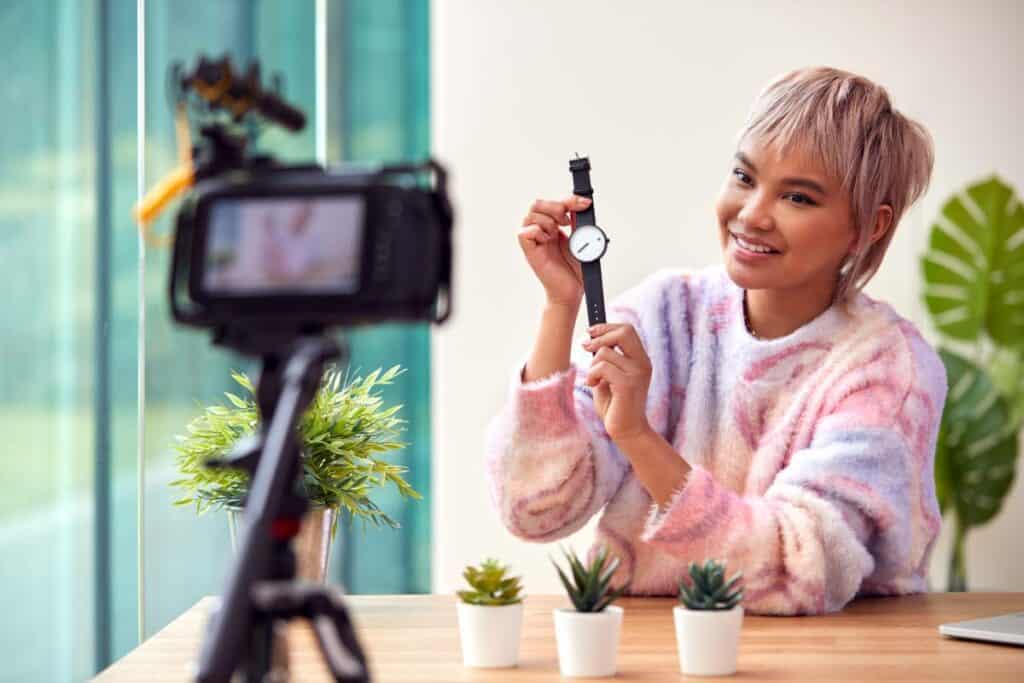Stepping into the world of Small Business Influencer Marketing can feel like navigating a maze without a map. But, it doesn’t have to be that way. We’re here to guide you through the twists and turns, ensuring your small business emerges on the other side not just intact but thriving.
Consider this article a lighthouse amidst the shadows, illuminating the potential of influencer collaboration as your next strategic masterstroke. From boosting brand awareness to getting more bang for your buck with strategic partnerships, we’ll cover it all. Plus, get ready to dive deep into choosing influencers who don’t just align with your values but amplify them.
Departing from our session, you’ll be armed with practical knowledge and bespoke tactics for petite enterprises keen on leaving a lasting impression via influencer partnerships. So let’s start this journey together and unlock new growth avenues for your brand.
Key Takeaways
- Jump into influencer marketing with authenticity to boost your brand’s visibility. Trust matters, so pick influencers who truly vibe with your brand for real impact.
- Focus on engagement over follower count to really connect. Make sure their values vibe with yours for a perfect match.
- Start by nailing down your goals—brand buzz, sales boost, or more social love. Then find the perfect influencer fit; nano for niche appeal, micro for broader reach.
The Power of Influencer Marketing for Small Businesses
Imagine your small business skyrocketing to fame overnight. That’s the power influencer marketing can wield in today’s digital age, where 71% of consumers trust influencers more than traditional advertisements. Leveraging this innovative approach has demonstrated its efficacy, yielding a remarkable return of $5.20 for each dollar invested in influencer initiatives.
Why Trust in Influencers Matters
Influencers, through their knack for forging genuine connections with followers, have ascended to a status where their endorsements are not only sought after but significantly sway consumer actions. When a well-respected influencer shares a product review or features your brand in a blog post, it translates into instant credibility for you. But why does this matter? Because consumer trust is everything in today’s market—it directly influences purchasing decisions and shapes brand perception.
Crafting an effective influencer marketing strategy requires pinpointing the perfect balance between an influencer’s passions and the interests of their audience, ensuring that the campaign strikes a chord with followers. This alignment creates authentic content that feels more like a friend’s recommendation rather than an ad, leading to higher engagement rates and ultimately driving sales.
To harness this influence effectively, small businesses need to pay attention not just to the number of followers an influencer has but also to how engaged their audience is—because at the end of the day, high engagement means people are listening closely.
Setting Goals for Your Influencer Campaigns
Before diving headfirst into partnering up with big names on social media platforms or reaching out to any TikTok influencer who seems relevant, it’s crucial first to define your goal clearly. Are you looking to increase brand awareness among active users within a specific geographic location? Or maybe boost engagement around new product launches?
Pinning down these objectives early ensures that every step taken aligns perfectly with achieving tangible results for your business—a must-have strategy when resources are limited yet aspirations high.
Selecting the Perfect Influencer for Your Brand
Finding influencers isn’t merely about choosing someone famous; it involves researching individuals who embody your ideal customer profile while sharing similar values as represented by your style guide (How Much Do Influencers Charge Per Post?). Whether they’re mega-influencers demanding upwards of $45k per post or nano-influencers charging significantly less but offering highly engaged communities—the right fit makes all the difference. And yes budget matters too: Nano-influencers cost approximately $500-$2k per collaboration whereas micro-influencers might set you back between $2k-$8k each time they promote you.
Setting Goals for Your Influencer Campaigns
Identifying Your Marketing Objectives
Before kicking off your influencer marketing adventure, pinpointing what you’re aiming to achieve is essential. Are you looking to increase brand awareness or drive sales? Maybe your aim is a higher engagement rate on social media. Pinpointing what you want out of the partnership sets the stage for a successful influencer marketing campaign.
To get this right, think about what matters most to your business at its current stage. When debuting a fresh offering, igniting excitement and enlightening prospective buyers often take center stage. On the other hand, if boosting online sales is your main focus, then finding influencers with high conversion rates might be where you’ll want to concentrate.
A well-defined set of marketing goals not only helps in selecting the right influencers but also in measuring the success of your efforts later on. For instance, if increasing website traffic was one of your objectives, tracking referral links from influencer posts will show whether those collaborations are paying off.
Selecting the Perfect Influencer for Your Brand
Finding that ideal influencer who aligns with both your target audience and brand values can feel like searching for a needle in a haystack. Yet, executing this task with precision can unlock extraordinary outcomes for your brand. It’s all about understanding who their followers are and ensuring there’s overlap with your ideal customer profile.
Nano-influencers might cost between $500-$2,000 per post as highlighted by Impact.com, making them budget-friendly options that often boast highly engaged communities perfect for niche markets or localized campaigns due to their specific geographic location appeal.
In contrast, micro-influencers charge more ($2k-$8k/post) but typically have larger followings which could give wider exposure—especially effective if aiming for broader market penetration without breaking bank accounts wide open.
Crafting Authentic Collaborations with Influencers
The best partnerships thrive on transparency and authenticity; two factors key not just during negotiation phases but throughout entire collaboration lifespans too. Being open and honest means setting clear expectations upfront including deliverables deadlines while respecting creative freedom within reason (brand style guide anyone?). This fosters trust and builds long-term relationships benefiting everyone involved: brands gain genuine content resonating well among audiences whereas influencers enjoy working environments where creativity isn’t stifled by rigid guidelines allowing true personality to shine through each piece created together collaboratively speaking.
Maximizing ROI on Instagram with Influencers
No surprise here – Instagram continues reigning supreme amongst various social media platforms. It’s got everything from eye-catching visuals to a huge, engaged audience ready to see what’s next. Hence, it’s the prime destination for both brands and creators looking to leave a mark in the digital realm.

Selecting the Perfect Influencer for Your Brand
Choosing the right influencer is like picking a new best friend for your brand. They need to understand you, vibe with your energy, and tell the world how awesome you are in their unique way. But where do you start? Let’s say goodbye to guesswork and hello to strategy.
Understanding Your Target Audience
To choose an influencer who will speak directly to your ideal customer, first get crystal clear on who that person is. Think about their interests, what social media platforms they hang out on most, and what kind of content keeps them engaged. This isn’t just about demographics; it’s diving deep into psychographics too.
If your target audience loves DIY home decor tips shared through quirky Instagram Reels or TikTok videos, then partnering with a big-name YouTuber might not hit the mark as much as collaborating with an up-and-coming TikTok influencer known for their creative home projects would.
Paying Attention to Engagement Rates Over Follower Count
A common misconception is that more followers mean better results. However, engagement rate—the percentage of followers who interact with an influencer’s content—is actually king when it comes to effective marketing efforts. Smaller influencers often have highly engaged communities because they can maintain personal connections with their audience.
Nano-influencers might only charge between $500-$2,000 per post but don’t let these numbers fool you—these smaller-scale influencers can pack a powerful punch in terms of engagement rates and genuine connection (How Much Do Influencers Charge Per Post?). Meanwhile, micro-influencers generally charge somewhere between $2,000-$8,000 per post but offer access to slightly larger audiences without sacrificing much by way of intimacy or engagement quality.
Finding Alignment With Your Brand Values
The core values of both your brand and chosen influencer should align like two perfectly matched puzzle pieces—not forced together but fitting seamlessly side by side. To ensure this alignment exists: – Examine past partnerships they’ve been involved in.
– Take note if they’ve ever represented competing brands.
– Review how consistently they create content that could resonate well within geographic location constraints relevant to yours (if any).
Dedicating hours to delve into the depths of an influencer’s history and ethos goes beyond merely skimming their latest updates. But trust us—it pays off significantly when every message put forth reinforces rather than detracts from those key elements at the heart of what makes up the identity behind the name logo proudly displayed across products/services offered under its banner. Delving into the core beliefs and principles of influencers guarantees a seamless match with your brand’s mission, enhancing every partnership’s authenticity and resonance with your followers.
Crafting Authentic Collaborations with Influencers
Small enterprises uncovering influencer partnerships is akin to stumbling upon an arcane arsenal, potent enough to catapult their brand into the limelight. But the magic really happens when these collaborations are built on authenticity and transparency. Embarking on a journey to create real connections with influencers can be your golden ticket to captivating their followers.
Why Trust in Influencers Matters
In today’s digital age, consumers have become more discerning about whom they trust online. A staggering 71% of consumers place their trust in influencers, which speaks volumes about the power of personal recommendation over traditional advertising. This level of trust doesn’t just happen overnight; it’s earned through consistent and honest communication between the influencer and their followers. When an influencer genuinely loves your product or service, this authentic endorsement translates to increased brand perception and sales for you.
Grasping the essence of this connection highlights the necessity for establishing authentic bonds based on transparency right from the outset to ensure influencer marketing triumphs. With every dollar spent on influencer marketing yielding an average ROI of $5.20, there’s no denying its effectiveness—but only if approached correctly.
Selecting the Perfect Influencer for Your Brand
Finding the right voice to represent your brand involves more than just numbers—it’s about alignment in values, style, and audience demographics too. Whether considering smaller influencers such as nano-influencers who might charge around $500-$2000 per post or micro-influencers whose rates typically range between $2000-$8000 per post (as detailed here), it’s crucial that their follower base mirrors your ideal customer profile.
This strategic approach not only ensures higher engagement rates but also builds a sense of community around shared interests—making each sponsored post feel less like an ad and more like a trusted friend making a heartfelt recommendation.
Cultivating Transparency with Audiences
To maintain credibility in any partnership, being open and honest is non-negotiable—not just between brands and influencers but towards audiences too.
Transparency regarding sponsored content helps prevent any potential backlash while fostering deeper connections among all parties involved.
It underscores respect for consumer intelligence by acknowledging upfront when posts are promotional—a practice appreciated by savvy social media users looking beyond mere transactions toward meaningful interactions instead.
By adopting strategies focused equally on clear disclosure practices as well as relationship-building fundamentals we ensure our message resonates authentically across various platforms resulting in sustainable growth fueled by both loyalty and innovation alike So remember be true to yourself yet adaptable enough to evolve alongside the ever-changing landscape of digital influence.
In the end, what really makes us stand out is staying genuine while being flexible enough to adapt to the constantly changing world of digital influence. This approach not only fosters trust but also encourages a loyal following that’s eager to see what we’ll do next.

Maximizing ROI on Instagram with Influencers
Instagram stands as a colossus in the influencer marketing arena, making it a prime platform for small businesses aiming to skyrocket their brand awareness. However, what gives this image-focused application its remarkable influence? Well, stats don’t lie: 30% of marketers report bagging the highest return on investment (ROI) from their Instagram campaigns. (make sure to also use hashtags in content marketing!)
Why Trust in Influencers Matters
Gone are the days when consumers blindly trusted advertisements. Nowadays, it’s genuine vibes that really capture people’s attention and spending. A staggering 71% of consumers place their trust in influencers over traditional ads. This seismic shift is because influencers have mastered the art of weaving stories around products, making them relatable to everyday life. Their endorsement acts like social proof that your product doesn’t just exist; it works wonders.
This trust translates into impressive numbers where influencer marketing boasts an average ROI of $5.20 per dollar spent according to recent findings by Impact.com. That’s not pocket change. This illustrates how adeptly managed collaborations with influencers can morph humble outlays into substantial financial gains for burgeoning enterprises.
Setting Goals for Your Influencer Campaigns
Diving headfirst without a clear objective is akin to sailing without a compass; you might move but probably not in the right direction. To avoid drifting aimlessly in the vast ocean of social media platforms, defining your goal becomes crucial. Are you looking to boost sales directly through promo codes or perhaps increase brand visibility among certain demographics?
Your objectives need alignment with overall business goals and should be measurable – think engagement rates or conversion metrics are specific enough so that at the campaign’s end you’re not left scratching your head wondering if it was worth it.
Selecting the Perfect Influencer for Your Brand
When you look for influencers, The essence lies not just in choosing any influencer but in finding ‘the one’ who echoes your brand values and speaks directly to your ideal customer’s heartstrings—someone whose followers hang onto every word they say about lifestyle choices or purchase decisions.
Finding this perfect match means sifting through various tiers—from nano-influencers charging roughly $500-$2,000 per post upping all the way up micro-influencers alley who may charge between $2,000-$8,000 per piece as detailed on Impact.com’s insightful guide. These figures underline how critical yet financially varied selecting an appropriate influencer can be depending upon the desired reach and engagement levels. Embarking on the quest for the ideal influencer transcends mere statistics; it necessitates a synergy with an individual whose ethos and aspirations resonate within your fiscal parameters.
Budgeting for Your Influencer Marketing Campaigns
When you’re dipping your toes into the influencer marketing pool, knowing where to allocate your dollars can feel like trying to navigate a maze blindfolded. But fear not. Armed with our expertise and tactical advice, simplifying your budgeting process becomes as easy as tracing a path on a chart.
Understanding Costs Across Different Tiers of Influencers
The world of influencers is vast, stretching from the stars of social media with followers in the millions down to niche micro-influencers who might wield influence over just a few thousand highly engaged individuals. Each tier comes with its own price tag. For instance, collaborating with mega-influencers could set you back up to $45,000 per post. That’s no small change. On the flip side, nano and micro-influencers offer more wallet-friendly options costing about $500-$2,000 and $2,000-$8,000 per post respectively. If those numbers have your head spinning faster than a top,
You may want to check out this guide on influencer charges. It breaks down what influences costs so you can start planning without playing guessing games.
Allocating Your Budget Wisely
Now that we’ve talked numbers let’s discuss how to use them wisely because throwing money at any influencer won’t guarantee success; it needs a strategy behind it.
First off—don’t put all your eggs in one basket or spend all your budget on one mega-influencer hoping for miraculous results; diversify instead. Consider mixing things up by investing in several smaller influencers whose audiences closely match your ideal customer profile or geographical location targeted for higher engagement rates.
This approach gives room for testing which collaborations yield better returns before committing more funds—a smarter way forward.
Finding Hidden Value: Nano-Influencers & Micro-Influencers
Sure, big names are tempting, but don’t overlook nano and micro-influencers – they’re often hidden gems when used correctly because their followers tend to be highly engaged compared to bigger accounts which means they could provide much higher ROI (return on investment).
These creators usually have closer relationships with their audience making recommendations seem like personal advice rather than paid endorsements hence increasing consumer trust significantly—an essential ingredient for successful campaign goals need today’s skeptical online environment.
So yes, while working with the big guns has its perks especially in terms of reach, sometimes focusing on the lower rung of the ladder pays dividends too. Moreover, experimenting with these budget-friendly options allows you to tweak and refine your communication methods and structures until you discover the perfect match that truly clicks with those you aim to engage.
FAQs
What is influencer marketing for small businesses?
Influencer marketing lets small businesses team up with popular folks online to boost brand visibility and sales.
Can a local business use influencer marketing?
Absolutely. Local businesses can partner with influencers in their area to reach potential customers more personally and effectively.
How much do small businesses pay influencers?
The cost varies, but smaller brands might shell out $500-$2,000 per post for nano-influencers or up to $8,000 for a micro-influencer.
How much should I charge as a small influencer?
Your rate depends on your follower count and engagement rates. Start by researching what others in your tier are charging.
How can small businesses reach out to influencers for marketing purposes?
Small businesses can reach out to influencers by sending personalized messages via email or direct messages on the best influencer marketing platform. When reaching out to influencers, it’s important to communicate the purpose of the campaign, the expected deliverables, and any compensation or incentives being offered.
What should small businesses consider when partnering with influencers in 2024?
When partnering with influencers in 2024, small businesses should consider the purpose of their campaign, the types of influencers that align with their brand values, and the usage rights for the content created. It’s best to work with influencers who can help achieve the business’s marketing goals and target the right audience.
Conclusion
Small business influencer marketing is a powerful tool for boosting brand visibility, driving sales, and fostering authentic connections with your target audience. By carefully selecting influencers who align with your values, setting clear objectives, and cultivating transparent partnerships, you can maximize your ROI and achieve sustainable growth. Remember, success lies in strategic planning, genuine engagement, and adaptability in the ever-evolving digital landscape. If you’re ready to elevate your influencer marketing game and unlock new growth opportunities for your brand, schedule a free consultation with our experts today. Let us help you navigate this exciting journey and achieve your business goals.






